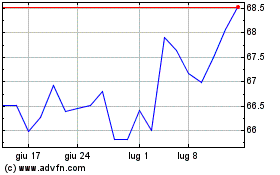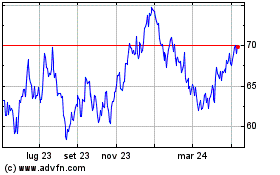By Rhiannon Hoyle in Jakarta, Indonesia, and Alexandra Wexler in Kalumbila, Zambia
From Congolese jungles to Indonesian highlands, a struggle is
raging between governments and major mining companies over control
of commodities vital to the production of everything from steel to
electric cars to smartphones.
Developing-world leaders, spurred by rising mineral prices, are
making their toughest demands on Western mining companies in years,
squeezing them to pay higher royalties and taxes, process
commodities locally and cede control of mines.
In Indonesia, Rio Tinto PLC and Freeport-McMoRan Inc. were
pressed to sell majority control of the world's second-largest
copper mine, Grasberg, to a government that aims to transform its
state-owned resources companies into industry behemoths.
Tanzania last year slapped a subsidiary of Canada's Barrick Gold
Corp. with a $190 billion tax bill -- four times the country's
gross domestic product. In March, Zambia handed Canada's First
Quantum Minerals Ltd. a tab for import duties and penalties
totaling roughly $8 billion. The Democratic Republic of Congo
signed into law a new mining code in June that will take a bigger
slice of miners' profits. Papua New Guinea, Mali, Sierra Leone and
others have also put mining contracts and legislation under
review.
"I will not hesitate to close down all the mines if companies
don't pay what they owe us," Tanzanian President John Magufuli told
a cheering crowd last year. "I have launched an economic war."
Governments say the countries deserve more of the profits from
the extraction of their resources. Demands for bigger stakes in
resource wealth have risen before -- often when prices go up -- but
people in the industry say fiscal and political pressures now are
hardening governments' resolve to extract more wealth from mining
conglomerates.
A wave of new, populist governments are struggling to pay the
bills after their countries borrowed heavily for infrastructure in
recent years. Governments see miners -- often the biggest companies
in the country, who have little flexibility to leave after years of
investments -- as potential sources of revenue. Prices of many
commodities have recovered, even though they aren't close to record
levels seen roughly eight years ago, and profits of the world's top
40 miners more than doubled last year.
"We are very profitable and therefore everybody -- communities,
governments -- wants to have a bigger share of the cake," Rio Tinto
Chief Executive Jean-Sébastien Jacques said in an interview.
Miners argue they deserve large profits because of the financial
risks they take and the huge upfront costs needed to explore and
build a mine. Still, miners say they have a new understanding of
the importance of disclosure in contracts, and of the need to be
more collaborative with governments to gain what they call a social
license to operate -- the widespread support of the community.
Some mining giants are staying put, contesting the moves or
trying to renegotiate terms with governments, which typically give
them the rights to dig up resources in exchange for royalty
payments. Others are turning to new investments at home, hoping
technology can help revive older sites. Anglo-Australian BHP Group
Ltd., the world's biggest mining company by value, says it wants to
focus on more-predictable places including Australia and the U.S.
after pulling out of South Africa, Mozambique, Indonesia and
elsewhere.
Some miners walking away are selling assets to local investors
or to Chinese companies, who are driven by demand at home and who
don't face the shareholder pressures over risk that Western miners
do. State-owned companies also tend to report less than listed,
international miners.
Mining executives say the resurgence of what they call resource
nationalism could stifle investment in new projects because of
increased costs and risk. Local miners may lack the capital or
skills to operate alone, potentially reducing output, they say.
Countries that depend on resources revenue to fund their budgets
could suffer.
For markets, fewer new supplies could send metals prices soaring
if global growth remains strong, potentially making products from
Tesla Inc.'s Model 3 to Apple Inc.'s iPhones more costly.
In Tanzania, populist Mr. Magufuli took power in 2015 in an
election marked by fraud allegations, and began centralizing power.
After campaigning on a promise to carve out a bigger stake in
resources for the state, the leader nicknamed "the Bulldozer"
canceled mining licenses for many companies, raised royalty
payments and accused Barrick Gold's subsidiary, Acacia Mining PLC,
of underreporting gold and copper production, leading to its $190
billion bill for unpaid taxes, penalties and interest.
The country also seized a U.K. miner's roughly $15 million
shipment of diamonds from an airport, claiming it had been
undervaluing exports, and banned exports of some metal concentrates
to force the development of its local refining industry.
Mr. Magufuli said the moves, which polls show are popular
locally, reset the balance between foreign companies and taxpayers
after many miners received sweetheart deals under previous
administrations.
Acacia, which accounts for 15% of Tanzania's total exports,
denied wrongdoing. Barrick last year said Acacia would pay $300
million as part of a deal to resolve the dispute, or nearly 40% of
Acacia's 2017 revenue, but a final agreement hasn't been
reached.
Acacia's production has nose-dived in the face of Tanzania's
export ban on metal concentrates, and the company has said it is
looking to sell a stake in some or all of its assets in the
country.
Zambia was long seen as being among the most investment friendly
countries in the region, but that has shifted. Its position as
Africa's No. 2 copper producer behind Congo helped spur economic
growth, bringing shopping malls and tidy brick homes to the
landlocked nation.
Copper prices, while healthy, are still down about 40% from
their 2011 peak, leaving the government with deteriorating
finances. Mining accounted for 12% of the country's GDP in 2016.
Zambian government debt is expected to balloon to 66% of GDP in
2018, from 27% five years ago.
First Quantum's Sentinel copper mine, which it built for $2.3
billion, went into production in November 2016. More than 45 giant
trucks haul rock out of the pit daily. Off-duty workers and their
families stroll along paved, tree-lined streets dotted with giant
anthills in a town First Quantum built for over $85 million.
This spring, Zambia delivered First Quantum a nearly $8 billion
bill for what it said were mislabeled import duties on machinery
and materials brought in to build Sentinel, as well as penalties
and interest. "We shall pursue all available options to the
authority to recover all taxes on behalf of the Zambian people," a
spokesman for the Zambia Revenue Authority said in March. Officials
declined to comment further.
First Quantum has denied wrongdoing. "We're just stunned there,"
Philip Pascall, chief executive of First Quantum, said on a call
after the fine was announced. "We completely refute the entire
amount." First Quantum said it was engaging in dialogue with the
government on the issue.
Zambia announced new mine tax measures in September, including a
royalty increase of 1.5 percentage points, a fresh 5% charge on
copper and cobalt concentrate imports and a 15% duty on the export
of precious metals and gemstones. The finance minister said the
measures are intended to ensure that "Zambians benefit from the
mineral wealth."
Across the Indian Ocean, in Indonesia, many foreign miners have
sold operations after years of revisions to mining policies.
Leaders in the mineral-rich archipelago nation have long wanted
foreign miners to share more profits, fueled by concerns they got
cushy deals under former dictator Suharto, who ruled until
1998.
Indonesia has focused on the Grasberg copper mine, by far its
most important asset, and to many Indonesians the biggest symbol of
foreign corporate power.
Located at more than 14,000 feet in the mountains in the remote
province of Papua, it has been a cash cow for Freeport, catapulting
the Phoenix-based company into the ranks of the biggest copper
producers, with $1.8 billion in profits last year.
It has also been a source of local controversy since its initial
contract was signed in 1967, which originally gave no stake to the
government. Contract negotiations then and in the decades that
followed were surrounded by reports of insufficient expertise
within the regime, and insider dealing between Suharto and his
inner circle and Freeport officials, documented in a Wall Street
Journal investigation in the 1990s. Freeport said that its contract
was fair.
The mine was also dogged with allegations that Freeport caused
environmental damage and colluded with Indonesia's military, which
has violently cracked down on separatists who oppose the mine.
Freeport said it adheres to the highest human rights standards and
is committed to minimizing its impact on the environment. It said
it has invested more than $14 billion at Grasberg over five decades
and has been one of Indonesia's largest taxpayers.
With its license running out in 2021, negotiations intensified
last year to give Indonesia more control and profit. Jakarta
canceled Freeport's export permit. "After 50 years we also have to
consider the people of Indonesia," Luhut Pandjaitan, coordinating
minister for maritime affairs, which oversees minerals, said last
year.
Freeport declared force majeure at the mine, laid off more than
10% of its 32,000 workers and threatened to take Indonesia to
arbitration.
Jakarta then threatened to cut off services needed to export
commodities, such as access to customs documentation, to mining
companies that weren't up-to-date with taxes owed under new
permits.
In early 2018, environmental officials ordered Freeport to start
recovering 95% of its waste from a nearby river in which it
discards the material known as tailings, from 50% of the waste
now.
Freeport chief executive Richard Adkerson said that was
impossible. "It cannot be done within six months, 24 months, five
years...This is so far out of bounds," he told investors. He said
he feared political motivations were behind the move.
Jakarta said the move wasn't politically motivated and was
sparked by violations seen during a site visit. Freeport's share
price fell 15% on the day the news became public. Shares are
currently near an 18-month low.
A deal was signed in September in which state-owned PT Indonesia
Asahan Aluminium, or Inalum, will pay $3.5 billion to Rio Tinto for
its interest in Grasberg and $350 million to Freeport, pushing
Inalum's stake from 9.4% to 51%. Freeport will retain 49% and
operate the mine. Mr. Adkerson earlier described the result as a
"major concession" but necessary for continued investment
there.
Freeport is hiring for a new copper project in Arizona, joining
the ranks of Western companies who are working to expand operations
in the U.S., Canada and Australia. The Lone Star resource was found
during exploration near the company's Safford mine, and production
is expected to begin by late 2020. Freeport forecasts the mine will
produce about 200 million pounds of copper a year, with a life of
around two decades.
Rio Tinto and BHP say autonomous vehicles and the ability to dig
deeper because of advanced climate-control systems and data
analytics have made it economically feasible to mine areas far
underground, such as at the pair's joint-venture Resolution Copper
project in Superior, Ariz.
South32 Ltd., a BHP spinoff, recently bought Arizona Mining and
its Hermosa zinc, lead and silver project in Santa Cruz County,
Ariz., for $1.3 billion. The company is working to unload a coal
unit in South Africa, where government policy requires miners to
sell large stakes to black-owned entities.
"We want to go to places where we are welcome and the friction
towards our investment is low," BHP chief executive Andrew
Mackenzie said in May.
--Nicholas Bariyo in Kampala, Uganda, contributed to this
article.
Write to Rhiannon Hoyle at rhiannon.hoyle@wsj.com and Alexandra
Wexler at alexandra.wexler@wsj.com
(END) Dow Jones Newswires
November 18, 2018 14:32 ET (19:32 GMT)
Copyright (c) 2018 Dow Jones & Company, Inc.
Grafico Azioni Rio Tinto (NYSE:RIO)
Storico
Da Mar 2024 a Apr 2024

Grafico Azioni Rio Tinto (NYSE:RIO)
Storico
Da Apr 2023 a Apr 2024
